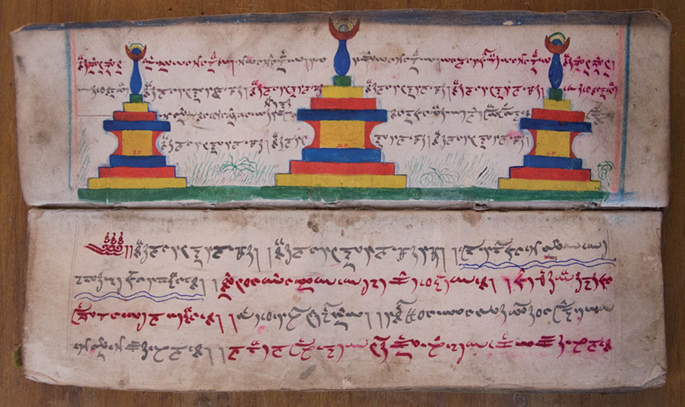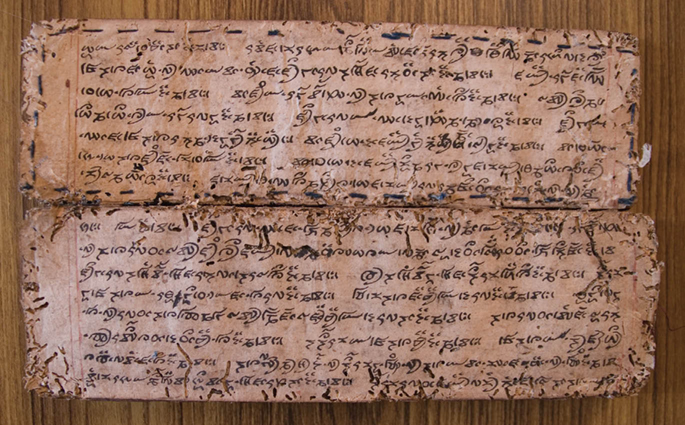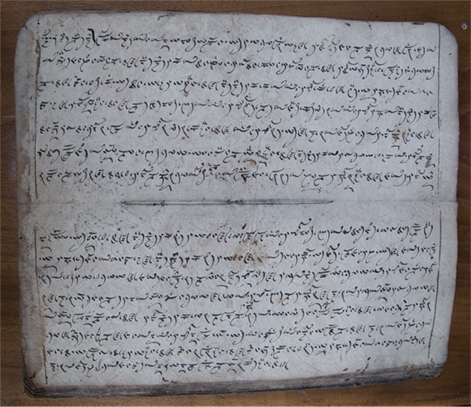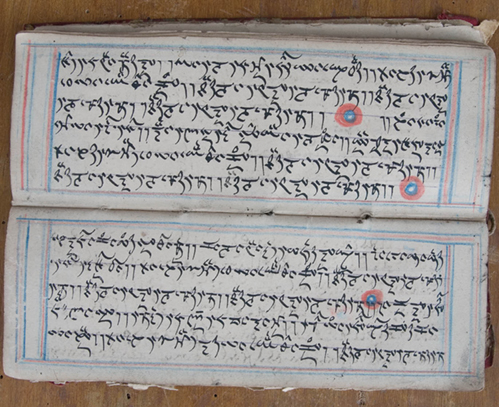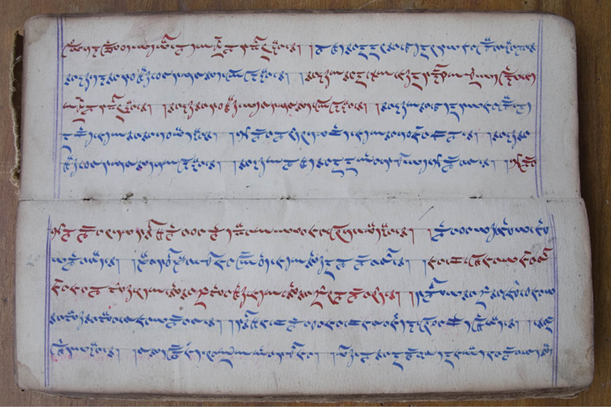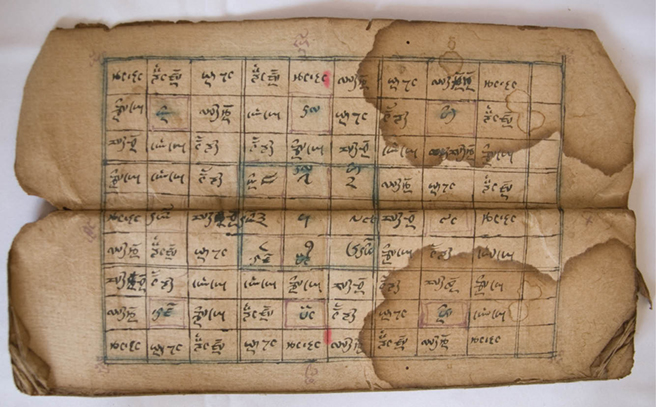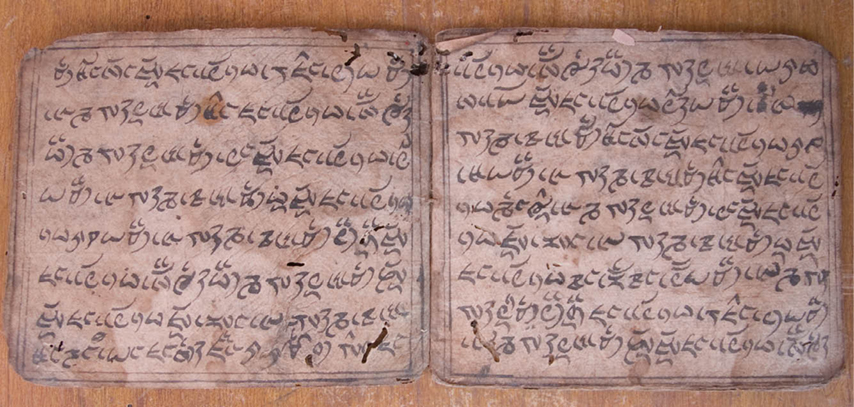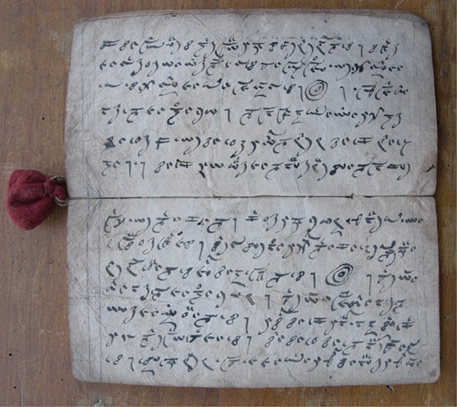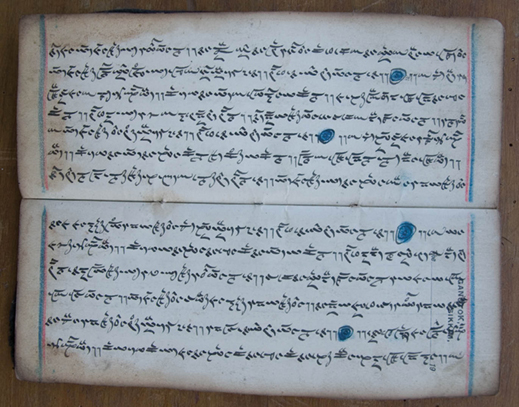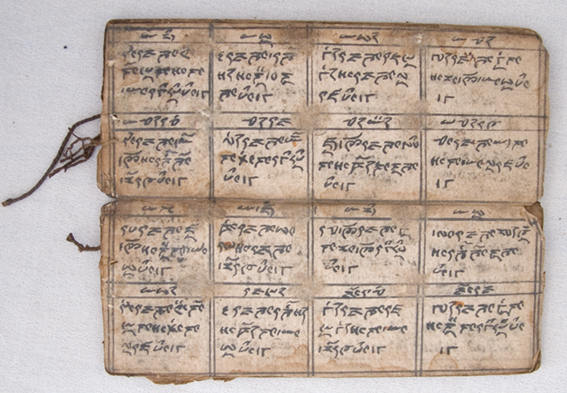3. Unravelling Lepcha manuscripts
© Heleen Plaisier, CC BY http://dx.doi.org/10.11647/OBP.0052.03
Lepcha is a Tibeto-Burman language spoken in the Indian state of Sikkim, the Darjeeling district in West Bengal, the Ilām district in Nepal, and in a few villages of the Samtsi district in southwestern Bhutan. The Lepcha people are regarded as the native inhabitants of Sikkim, and most of the areas in which Lepcha is spoken today were once Sikkimese territory. The exact position of Lepcha within the clade of Tibeto-Burman languages is still unclear. The current number of Lepcha speakers is estimated to be around 30,000, but many Lepchas today never mastered the language fluently and give preference to Nepali and English.1
Fig. 3.1 Prayers to the Choten. Foning Collection (EAP281/1/9), CC BY.
Although there are still areas in which the Lepcha language flourishes, the culture has been losing ground for over 100 years. Lepcha manuscripts represent the oldest stages of the Lepcha literary tradition and with the endangerment of the Lepcha language and culture, the survival of these texts is at risk. Many Lepcha texts are based on Tibetan originals and combine elements of non-Buddhist native Lepcha religious beliefs with Tibetan Buddhist values and traditions (Fig. 3.1). Any study of Lepcha civilisation cannot ignore the enormous impact of the Tibetan language and culture, a research topic that has so far received little attention.
Fig. 3.2 Worship of Ekádoshi. Tamyong Collection (EAP281/3/1), CC BY.
Many aspects of Lepcha culture, literature and religion are as yet undocumented. It is of paramount importance to document and describe these traditions before they become too eroded, and to work towards a balanced interpretation of their precise nature. This chapter presents the first steps in unravelling the Lepcha materials that were recently digitised through the Endangered Archives Programme (EAP), in order to highlight their significance and encourage further research.2
Written Lepcha
The native Lepcha orthography
The Lepcha people maintain a literary tradition that dates back to the eighteenth century. The Lepcha script is understood to have been devised at the time of the third chogyal of Sikkim, Chador Namgyal, who reigned from 1700-1716. According to Lepcha tradition, the native Lepcha orthography was created by the Lepcha scholar Thikúng Mensalóng, who is believed to have been a contemporary of Lama Lhatsun Chenpo, i.e. Lama Lhatsun Namkha Jigme (1597-1654), the patron saint of Sikkim, who played a definitive part in the Sikkimese conversion to Buddhism. Since sources mention that Mensalóng and Lhatsun Chenpo met each other,3 they may well have worked together on the Lepcha orthography, which would account for a Tibetan tradition which ascribes the introduction of the Lepcha script to Lhatsun Chenpo. The Lepcha tradition that credits Mensalóng with the invention of the Lepcha script seems even more plausible when we realise that the Limbu or Kiranti script was also developed during the reign of Chador Namgyal, not by Chador Namgyal himself, but by the Limbu monk Śirijaṅgā.4
It has been suggested that there was a literary tradition amongst the Lepcha before the arrival of Buddhism, and that Lepcha texts were destroyed by Tibetan Buddhist monks in the seventeenth century.5 These suggestions are not supported by evidence, but it is important to point here to a striking parallel in Limbu history, where Limbu books that reflected the shamanistic Limbu religion were forbidden and destroyed by the regime, and the inventor of the Limbu script, Śirijaṅgā, was killed by Buddhist monks after having used the script to write down non-Buddhist Limbu traditions.6
The native Lepcha orthography is systematically treated in a work entitled Lazóng,7 which is traditionally used to teach the first steps of reading and writing Lepcha.8 Customarily, Lazóng is recited by a teacher in a set melody, which enables his audience of students to read and chant along, memorising the values of the letters and syllables in the process. Although this work might seem to be a rather insignificant list of letter combinations to the outsider, the Lazóng represents an old, powerful and important Lepcha tradition. It is said that the next step in the traditional approach would be to practise writing by using a work entitled shuyuk hlápjen, but no surviving copies of this book have yet been identified. Although most people nowadays learn to read and write Lepcha through different methods, the traditional method based on recitation of the Lazóng is still practised in some areas. The traditional order of the Lepcha alphabet in the Lazóng is different from the order found in modern primers and textbooks, and even modern versions of the Lazóng,9 which follow the order of the devanāgarī alphabet.
Lepcha literature comprises various literary genres, such as folk tales, poetry, fiction and religious works. The subject has as yet received little scholarly attention and only a few transcriptions, translations and analyses of Lepcha works have been published to date. Albert Grünwedel, the Tibetologist who edited the Lepcha dictionary manuscript left behind by George Byres Mainwaring, published several Lepcha texts that display clear links to Tibetan works.10 An excellent account of traditional Lepcha stories was published by C. de Beauvoir Stocks,11 and René de Nebesky-Wojkowitz wrote an article on the Lepcha, “Legende vom Turmbau [Legend of the Building of the Tower]”.12 Several Lepcha legends are described in the publications of Geoffrey Gorer, Matthias Hermanns, Amal Kumar Das, George Kotturan and Richard Keith Sprigg.13 Halfdan Siiger and Jørgen Rischel include descriptions of various Lepcha myths in their book, as well as analyses and translations of over forty short Lepcha texts.14 I published a transcription and translation of two Lepcha resurrection texts,15 and Arthur Foning provides a translation and discussion of various important Lepcha legends.16 Of particular value are Khárpú Támsáng’s books on Lepcha mythology, which capture traditional stories in the Lepcha language.17
Lepcha manuscripts
The oldest handwritten materials in Lepcha to have been identified were written in the second half of the nineteenth century. Lepcha texts are written on paper and are usually in book form, either handmade volumes or machine-made exercise books. Some Lepcha manuscripts are in concertina form, and occasionally they consist of loose sheets. Dog-ears, small stains, mould, insect and worm demage (Fig. 3.2), weakened paper, discoloration of ink, grease stains, damp stains and water spots occur in almost all Lepcha manuscripts.
Over the centuries, religious Lepcha texts have been meticulously copied by hand by devoted scribes, a tradition which continues to date. Copies are made to ensure the survival of the texts and to pass them on to others. The act of copying these books by hand is considered to be a devoutly religious task that should not be undertaken without respect for the meaning of the text. The copyist may add a short colophon to the work, which is a text passage in which the name of the scribe, the place, year, month, day and in some cases even the time of the transcript is given.
If the text was not copied per se, but written down by the scribe whilst being narrated or recited by someone else, this may also be mentioned in the colophon. The colophon is a personal contribution of the scribe and is generally written in a style different from the rest of the work — it is usually more personal and more direct. In addition to a few personal words, the colophon typically contains certain solemn and honorary phrases and prayers, which are used by the scribe to urge the reader to treat the text with respect and to take to heart its moral lessons.
Over 200 Lepcha manuscripts are held in European libraries, universities and museums. This number relates to the number of physical manuscript volumes, but one manuscript volume often contains several literary works. The largest collection of Lepcha manuscripts can be found in the collection of the Kern Institute at Leiden University, and consists of 182 manuscripts collected by Johan van Manen (1877-1943).18 The Museum für Völkerkunde in Vienna houses seven manuscripts collected by René de Nebesky-Wojkowitz (1923-1959), and the National Museum in Copenhagen has twelve manuscripts collected by Halfdan Siiger (1911-1999). The School of Oriental and African Studies in London houses five Lepcha manuscripts. There are a further seven in the British Library; six of these volumes were collected by Brian Houghton Hodgson (c. 1800-1894) and one by Lawrence Augustine Waddell (1854-1938).
Fig. 3.3 The Legend of the Goddess Queen. Foning Collection (EAP281/1/20), CC BY.
For three months in 2009, with the support of EAP, I explored the Lepcha manuscripts surviving in private collections in Sikkim, Darjeeling and Kalimpong. The aim of this project was to locate collections of manuscripts, identify the texts, and discuss with owners the possibility of digitising their materials for preservation. The project was supported by a local partner, the Namgyal Institute of Tibetology in Gangtok (Sikkim, India), which itself houses thirty Lepcha manuscripts, the description and digitisation of which were included in the project.
During the project we have consulted and described six private collections of Lepcha manuscripts.19 These are the collections of the late Arthur Foning of Chyu-Pundi Farm in Mongbol Basti in Kalimpong, Óng Tshering Namchu of Mane Gombú village in Kalimpong, Dendrúp Adyenmú Lepcha of Mane Gombú, now residing in Gangtok in Sikkim, Chuksung Lepcha of Lower Burtuk in Sikkim, Tamyong Lepcha of Luknyi (Linge Payong) in Sikkim, and Chong Róngkup of Pulungdung near Darjeeling. Foning (1913-1987) was a renowned Lepcha scholar who published various works on Lepcha culture. Chuksung Lepcha works as a government official in Sikkim and is active in several groups with a vested interest in the preservation of Lepcha heritage. Dendrúp Lepcha is a well-known literary figure, researcher and journalist in Gangtok with an enduring passion for Lepcha cultural studies. Óng Tshering Namchu, Tamyong Lepcha and Chong Róngkup all practice as bóngthíngs, traditional Lepcha religious specialists, and as such regularly use their Lepcha manuscripts for recitation during religious ceremonies.
These collections contain 89 manuscripts altogether, of which forty were selected for digitisation.20 Preference was given to rare and unusual titles, and only a few copies were included of better-known works. Some manuscripts were too fragile to be included in the digitisation. The manuscripts we have digitised were produced between 1894 and 1963 by Rapdensíng Foning, Núrshíng Lepcha, N. S. Kárthák, Nákphye Lepcha, Khámbú Singh Lepcha, Tshángdo Tshering Lepcha, P. T. Lepcha, Thilok Lepcha and other unnamed or presently unidentified scribes. All manuscripts remain in the owners’ private collections. The digitised copies of these manuscripts are available online through the EAP, and copies are also accessible upon request at the Namgyal Institute of Tibetology.21
Lepcha literature
Lepcha religious beliefs
The central religious roles in the Lepcha community are traditionally occupied by the mun and bóngthíng, who both function as shamans. The bóngthíng is traditionally a male shaman who presides at recurring religious ceremonies and seasonal festivals and may heal acute illness. The mun, often but not necessarily a female shaman, is a healer who exorcises demons, helps to heal illness and guides souls to the afterlife. It is possible for a bóngthíng to develop into a mun; in Sikkim such healers are known as padem. The indigenous religious beliefs of the Lepchas were undoubtedly influenced by Tibetan Buddhist values and traditions since the introduction of Buddhism in Sikkim, but especially since the establishment of the Namgyal dynasty in the seventeenth century.22 Indigenous Lepcha shamanism coexists with Buddhist customs and beliefs, so that at many important ceremonies in Lepcha life, both Buddhist lamas and Lepcha bóngthíngs preside, each to perform their own rituals.
Popular Lepcha texts
It is generally assumed that the majority of religious Lepcha texts are of a Buddhist nature, but since the texts also appear to display at least some elements of the native Lepcha religious beliefs, they are generally regarded as adaptations rather than direct translations of Tibetan Buddhist texts:23
If one goes through these books carefully, it will be seen unmistakably that, apart from the plain copying down from the original Tibetan texts, the stories have been presented and given out to the readers in a complete Lepcha aura. The readers will feel that these stories etc. were written by the Lepchas themselves, and for themselves, exclusively.24
No research to date has compared these Lepcha adaptations with the Tibetan originals. The lack of adequate dictionaries and relevant text editions make the translation of Lepcha texts a challenging affair and only few transcriptions, translations or analyses of Lepcha manuscript texts have been published to date. Also, the abundant spelling variations or spelling errors that are present in Lepcha manuscript texts can be problematic. The identification of strands of native traditions in Lepcha literature is further complicated by our limited knowledge of the ancient Lepcha religious beliefs. Moreover, only few Lepchas can still read the handwriting and comprehend the language used in old texts.
In the titles of Lepcha works we often find an indication of genre, such as sung (story, narrative), cho (book, learning), munlóm (prayer, blessing), or námthár (legend, biography). These designations are obviously direct loans from equivalent categories in Tibetan literature, i.e. Tibetan Gsuṅ, Chos, sMon-lam and rNam-thar. Indeed, a Lepcha book, referred to as cho, typically conveys a canonical message, whereas a munlóm is usually a prayer book of some kind. A Lepcha námthár is generally a text containing a sacred legend, some chapter of native lore or a hagiography about the life of a saint or miracle-worker. The Lepcha term sung is used specifically for traditional stories that were originally not written down, but transmitted orally. In a broader sense, sung refers to narratives or stories in general.
Some Lepchas indicate any text with a Buddhist connection by adding the designation námthó námthár or námthár cho. Most popular works exist under different titles, such as tashe thíng sá námthar, tashe thíng sá cho, and tashe sung, or chotyen munlóm, chotyen námthár, or even chotyen munlóm sá sung and chotyen munlóm sá námthár. Whether these different titles represent different versions of the text is still an open question. In colloquial Lepcha, designations such as munlóm and námthár are pretty interchangeable, and appear to be used not so much because of their literal meaning, but rather their connotation of indicating some kind of sacred text.
The pivotal work in Lepcha literature is entitled Tashe sung [The Story of Lord Tashe].25 This book describes the legendary life of Tashe thíng (Lord Tashe), who is equalled to Padmasambhava in the Tibetan Pad-ma thaṅ-yig. The book describes different events in Lord Tashe’s life, his extraordinary powers and knowledge, his views on life and death, his battle against evil and the blessings he was able to spread around. Parts of this work are traditionally recited twice a day by Lepcha people: in the early morning and late evening. Lepcha texts are recited or chanted in a specific manner, referred to as nyumjó (melody, tune). There is a range of such chanting styles, of which the simplest and most commonly used is referred to as shímvunmú ʔúng tasót nyumjó (flowing melody).26
There are other Lepcha works that are subsidiary to the Tashe sung, and in a sense all these texts form part of a large epos about Lord Tashe’s life and work. For example, the work Rum pundi sá námthár [The Legend of the Goddess Queen] describes how Lord Tashe is struck by the troubles and suffering of human beings on earth, and how he sends his wife to earth to fight the bad influences that prevail there (Fig. 3.3).27 She tries to lead three wicked kings to a righteous and more religious path by taking birth as one of the king’s daughters. Since her suffering is so great, Lord Tashe himself takes birth as one of the king’s sons, and ultimately succeeds in fighting evil.
Another work found in many copies is Chotyen munlóm [Prayers to the Choten], a book of prayers, ritual ceremonies and offerings, which is intended to demonstrate the formulae for showing devotion and expressing worship.28 The book explains that the reading of prayers procures blessings. Chotyen munlóm is partly written in the form of a dialogue between sángge kungáwu (Lord Buddha) and tukbo thíng (Lord Tukbo). This is a book of prophecy, which predicts and describes calamities that mankind will have to suffer. According to René de Nebesky-Wojkowitz, this text corresponds to the Tibetan text mChod-rten sMon-lam, about the Bya-ruṅ kha-śor stūpa at Kathmandu.29
In several manuscripts we have found the work entitled Lopân birútsáná [The Learned Master Birutsana], which contains wise sayings, moral and ethical instructions of a contemporary of Padmasambhava, who in Tibet is known as Slob-pdon Vairocana.30 Foning pointed to this title as the source of many expressions in the Lepcha language, often referred to as tungbór (idiom) and ríngdyul (metaphor).31
Another example of a popular work attested in manuscripts we digitised, Cenrejú sá námthár [The Legend of Cenrejú], is based on the legend of Cenrejú, the Boddhisattva of compassion (Tibetan Spyan-ras-gzigs, Sanskrit Avalokiteśvara) (Fig. 3.4).32 Cenrejú tries to liberate all living beings from all kinds of suffering, but eventually has to accept that his goal cannot be reached without help. He despairs and consequently his head splits into many pieces. The Buddha (Amitābha) puts his body back together and creates a body with many different arms and heads, which will enable Cenrejú to fight many different kinds of suffering all at the same time. Cenrejú is sometimes portrayed with a thousand arms and eleven heads, and is then called Ekádoshi.
Fig. 3.4 The Legend of Cenrejú. Foning Collection (EAP281/1/6), CC BY.
We have also found texts related to the worship of Ekadoshi (Sanskrit Avalokiteśvara Eka-daśa-mukha) such as Ekadoshi sa munlom [Worship of Ekadoshi] (Fig. 3.2).33 The text describes the life of the virtuous king Bírbáho and explains the cult of Ekádoshi, in which it is customary to fast and pray once a year for two whole days and one whole night. In the book, the existence of different religions in the world is explained, and the need for tolerance towards other religions, such as Hinduism, is strongly emphasised. This Lepcha title may correspond to the Sanskrit-Tibetan work I-kā-da-śa sMon-lam.
Other popular texts we found are Tángku námthár [The Legendary Origin of Tobacco] which explains the demonic origins of tobacco and the dangerous consequences of its use,34 and Tukfíl sá námthár [The Legend of the Ants], a popular story that demonstrates the value of mutual respect between living creatures.35 The latter text describes how, while a priest is meditating, an ant walks over the table in front of him. The priest flicks the insect off the table, and nearly kills it. The ant is shocked and asks the priest angrily if he realises that he came close to killing it. The priest is not moved and the ant takes the matter to the ant-king who attacks the priest with his army, in order to teach him a lesson. The terrified priest prays for help and is rescued by a magic light which frightens the ants away. In the end no one is hurt, but the priest and the ants learn to respect each other.36
Another lively story is recounted in the book Guru choʔóng which contains the records of the pious Guru Choʔóng and his sinful mother Gompúkít.37 This work may be based on the Tibetan Gu-ru Chos-dbaň gi rNam-thar, a story about Padmasambhava. Trímík kunden sá námthár [The Legend of Trímík Kunden] is the Lepcha version of the Tibetan legend Dri-med Kun-ldan rNam-thar, based on the Viśvantara or Vessantara Jātaka, the last great birth of the Buddha, and describes many heroic sacrifices made by the charitable prince.38
Fig. 3.5 The Legend of the Goddess Nángse. Foning Collection (EAP281/1/13), CC BY.
Lepcha resurrection texts
In Lepcha literature we also find a group of texts in which people relate their experiences in the afterlife. This literature describes the experiences of those who meet their death and are subsequently sent back to the living to recount the torments to which sinners are subjected after dying. In the Lepcha language, their accounts are referred to by the term delúk, literally “resurrection” or “revenant”. The term delúk is akin to the Tibetan phrase ḥDas-log, which is used for Tibetan narratives of a similar nature. These tales are found in Tibetan as early as the seventeenth century and in Lepcha since the eighteenth century. The genre is generally understood as a mediation of Buddhist doctrine through traditional Tibetan beliefs. 39
While a number of Lepcha delúk texts are clearly based on Tibetan originals, others may be original Lepcha texts in the ḥDas-log tradition. Two delúk texts that are well-known from Tibetan literature were frequently copied in their Lepcha versions; these are the stories of Língse chokít and Kármá ʔóngjun. Other examples of Lepcha delúk texts are Sakon delúk sá sung [The Story of the Resurrection of Sakon], Nungyang mun delúk [A Nun’s Return from Hell], Phyukbú pake sá námthár [The Legend of the Wealthy Man Pake], Thóngsál Drámmo námthár [The Life of Thóngsál Drámmo], Mun Tembú sá delúk [The Resurrection of the Priestess Tembú] and Rummít Nángse sá námthár [The Legend of the Goddess Nángse] (Fig. 3.5).40
Fig. 3.6 Astrological text. Namchu Collection (EAP281/2/1), CC BY.
Fig. 3.7 Astrological text. Foning Collection (EAP281/1/10), CC BY.
Lepcha astrological texts
There are many astrological works in Lepcha, in fact the majority of the forty manuscripts digitised through the EAP contain texts belonging to this category. In traditional Lepcha life, astrology is used in many different ways. Astrology concerns itself with the prediction of the many different things to happen in a person’s life and focuses on the reading of auspicious and inauspicious signs and omens. It is believed that the fate of a human being can be influenced by his actions. Astrology can help to support religion by suggesting appropriate religious practices. It is also connected to the field of medicine, because it can help in diagnosing and curing diseases. Apart from casting horoscopes and offering an analysis of a person’s character or personality, astrology is also used in determining the suitability of marriage partners, and to advise travellers and farmers.41
Fig. 3.8 Astrological text. Foning Collection (EAP281/1/14), CC BY.
Lepcha astrological texts, sometimes simply referred to as tsu (astrology; Tibetan rTsis)42 have not yet been studied at all, and it has not yet been possible to identify many of the digitised material (Figs. 3.6, 3.7, 3.8 and 3.10). There appear to be clear links between Lepcha astrology and traditional Tibetan astrological traditions, for example the text Parkhó sá tsu [Parkhó Calculations] (Fig. 3.9) appears to relate directly to the Tibetan tradition of geomantic diagrams, described in sPar-kha-hi rTsis.43 One of the astrological works in Lepcha that is often encountered in manuscript form is called in full khyenrúng díngngá sá tsu kyân sá cho, but is often referred to simply as tsu kyân sá cho [Book of Astrology].44 It is thought that this book consists of several volumes relating to birth, journeys and marriage, some of which have been found copied independently, e.g. ʔágek ʔálát sá tsu (birth horoscopes) and brí sá tsu (marriage horoscopes).45
Fig. 3.9 Parkhó Calculations. Foning Collection (EAP281/1/7), CC BY.
Funerary texts relate to death and funerary traditions that are read aloud or chanted from memory in the presence of a person who is dying or has just passed away. In Lepcha literature, the title thókdra serves as a cover term for all Lepcha funerary texts, among which is the book entitled thókdra itself, but also works such as ʔámák sá munlóm, nyúthíng lóm frón, and possibly some of the titles designated shang sá tsu.46
The Lepcha designation shang sá tsu refers to “death horoscopes”. The reading of the death horoscope is essential for the organisation of the funeral ceremony. Every ritual action is based on the conclusions reached by the astrologer. Among the most significant of the calculations are the immediate cause of death, the prediction of the future destiny of the spirit and the handling and timing of the removal of the deceased body.
The Tibetan Buddhist tradition is such that traditionally, to help the deceased travellers gain insight into their situation, a monk or skilled layperson will recite guiding instructions and inspirational prayers from special funerary texts, sometimes referred to as Bar-do Thos-sgrol, or the Tibetan Book of the Dead. The term thókdra appears to be the Lepcha spelling of the Tibetan Thos-sgrol. The Lepcha thókdra contains words of guidance and consolation to the departed spirit, and is recited by the mun at the time the funeral pyre is lit. Some versions of this text or parts of it are written in the second person, as if speaking directly to the deceased. The first part of this book emphasises that the belief in the holy scriptures alone will guide the departed soul to heaven. In the second part, the departed soul is consoled by the words that death is inevitable. The deceased is persuaded to have left the world of the living; it is pointed out that the deceased cannot cast any more shadows, and can step silently on dried leaves or twigs without breaking them. In the third part, the departed soul is cautioned against the tricks of evil spirits who will take the form of loved and near ones, and is directed to pay homage to the gods. In the last part, the deceased has been guided to the abode of gods and the text concludes by consoling the departed soul.
Although they generally coexist, the native Lepcha religious beliefs and Tibetan Buddhist beliefs sometimes contradict each other. The Lepchas use the term sanglyon to refer to both the Tibetan Buddhist and the Lepcha rituals for guiding the soul of the deceased from this world to their next destination. For the Lepchas there is traditionally no judgement in the afterlife, and once the soul reaches its destination it lives on forever among all other immortal spirits.47 The Lepchas traditionally believe that people who have died shall never return to our world benevolently: they can only ever have contact with our world again in the form of múng (evil spirits). After death a soul can be converted into an evil spirit while it is in tongdek márdek lyáng (the netherworld), and the risk of this happening is provoked when death occurs suddenly, violently, at a young age, or when the proper funerary ceremonies are not conducted. In contrast, the Tibetan Buddhist soul is judged after death and consequently guided to its next incarnation. From glancing at the contents of the funerary texts, it appears that belief in a judgement of the soul by the Lord of the Dead, choge pano (Tibetan Chhos-kyi rGyal-po); the migrations of the soul through the perils of the Bar-do, the stage between death and new life, to its rebirth in one of the “six worlds”; the punishment of sinners in hell or nyó lyáng (Tibetan dMyal ba); and other well known traditions of Tibetan Buddhism are now widespread among the Lepchas.
Fig. 3.10 Astrological text. Dendrúp Adyemnu Collection (EAP281/4/3), CC BY.
Conclusion
The discussion above illustrates the richness of the religious and literary tapestry of the Lepcha people that is perpetuated in their manuscripts. Preservation of the archival materials that represent the earliest stages of the Lepcha literary tradition not only ensures that the Lepcha people continue to have access to their own heritage, but also enables further research into the various strands of influence of Tibetan Buddhist traditions, non-Buddhist Tibetan beliefs and linguistic evidence that can be unravelled in Lepcha traditions.
The study of Lepcha manuscripts is still in its early days, but it is expected to shed light on the nature of indigenous Lepcha religious beliefs and the spread of Buddhism in the area, while from a linguistic point of view the language used in these old texts is of historical interest. One impediment to progress in establishing the exact position of Lepcha within the Tibeto-Burman languages is the limited understanding of historical phonological borrowing of Tibetan into Lepcha. Linguistic analysis can also engage our literary and cultural questions; a comparative study of loanwords and calques will elucidate which Tibetan Buddhist concepts the Lepcha regarded as foreign and which they saw as parallel to their own traditions.
Elaborating such linguistic and literary influences will, in turn, promote more general insight into the way a foreign religion may be adapted to a local culture. The complex influence Tibetan Buddhism has exercised on the religion, literature and language of the Lepcha people has parallels with the experience of many other indigenous peoples in the region.
References
Das, Amal Kumar, The Lepchas of West Bengal (Calcutta: Editions Indian, 1978).
Driem, George van, Languages of the Himalayas: An Ethnolinguistic Handbook of the Greater Himalayan Region (Leiden: Brill, 2001).
Folk Tales of Sikkim (Delhi: Sterling, 1989).
Foning, Arthur, “A Short Account of the Lepcha Language and Literature”, Bulletin of the Cultural Research Institute, 13/3-4 (1979), 20-30.
—, Lepcha: My Vanishing Tribe (New Delhi: Sterling, 1987).
Gorer, Geoffrey, Himalayan Village: An Account of the Lepchas of Sikkim (London: M. Joseph, 1938).
Grünwedel, Albert, “Drei Leptscha Texte, mit Auszügen aus dem Padma-than-yig und Glossar”, T’oung Pao, 7 (1896), 522-61.
—, “Ein Kapitel des Ta-she-Sung”, Festschrift für Adolf Bastian (Berlin, 1896).
—, “Leptscha-Text mit Übersetzung”, Veröffentlichungen aus dem Königlichen Museum für Völkerkunde zu Berlin, 4 (1897), 118-26.
—, “Padmasambhava und Mandarava: Leptscha Übersetzung des Mandarava-Legende”, Zeitschrift der Deutschen Morgenländischen Gesellschaft, 52 (1898), 447-61.
—, “Padmasambhava und verwandtes”, Baessler-Archiv, 3 (1913).
Hermanns, Matthias, The Indo-Tibetans (Bombay: Fernandes, 1954).
Klafkowski, Piotr, “Rong (Lepcha), The Vanishing Language and Culture of Eastern Himalaya”, Lingua Posnaniensis, 23 (1980), 105-18.
Kotturan, George, The Himalayan Gateway: History and Culture of Sikkim (Delhi: Sterling, 1983).
Mainwaring, George Byres, A Grammar of the Rong (Lepcha) Language as it Exists in the Dorjeling and Sikim Hills (Calcutta: Baptist Mission Press, 1876).
Nebesky-Wojkowitz, René de, “Die Legende vom Turmbau der Lepcha”, Anthropos, 48 (1953), 889-97.
Plaisier, Heleen, Catalogue of Lepcha Manuscripts in the van Manen Collection (Leiden: Kern Institute, 2003).
—, A Grammar of Lepcha (Leiden: Brill, 2007).
—, “Two Lepcha Delúk Texts”, in Medieval Tibeto-Burman Languages IV, ed. by Nathan Hill (Leiden: Brill, 2012).
Róng sung gyom (Kalimpong: Lepcha Association, 2002).
Siiger, Halfdan and Jørgen Rischel, The Lepchas: Culture and Religion of a Himalayan People (Copenhagen: Gyldenal, 1967).
Simik, Pâsóng Choríng, “Rhythmic Tones in Reading Lepcha Religious Books”, Aachuley: A Quarterly Lepcha Bilingual News Magazine, 2/3 (1998), 17-18.
Sprigg, Richard Keith, “The Lepcha Language and Three Hundred Years of Tibetan Influence in Sikkim”, Journal of the Asiatic Society, 24 (1982), 16-31.
—, “Hooker’s Expenses in Sikkim: An Early Lepcha Text”, Bulletin of the School of Oriental and African Studies, 46/2 (1983), 305-25.
Stocks, C. de Beauvoir, “Folklore and Customs of the Lap-chas of Sikkim”, Journal and Proceedings of the Asiatic Society of Bengal, new series 21 (1925), 325-505.
—, “A Rong Folk Tobacco Story”, Folklore, 37 (1926), 193-95.
Támsáng, Khárpú, Róng Chomíng ân Lâzóng (Kalimpong: Mani Printing Works, 1982).
—, Róng Tóm Sung: A Treasure of the Lepcha Moral Stories (Kalimpong: Lyangsong Tamsang, 1999).
Archival resources48
EAP281/1/6
Cenrejú sá námthár.
EAP281/1/9, EAP281/5/3
Chotyen munlóm.
EAP281/1/23, EAP281/2/3, EAP281/3/1
Ekádoshi sá munlóm.
EAP281/1/8
Gúrú choʔóng.
EAP281/1/14
Khyenrúng díngngá sá tsu kyân sá cho.
EAP281/1/11
Lazóng.
EAP281/1/15, EAP281/1/18
Lopân birútsáná.
EAP281/1/4, EAP281/1/12, EAP281/2/1
Parkhó sá tsu.
EAP281/1/20
Rum pundi sá námthár.
EAP281/5/1
Sakon delúk sá sung.
EAP281/1/13
Rummit nángse sá námthár.
EAP281/1/1, EAP281/1/2, EAP281/1/4, EAP281/1/9, EAP281/1/16, EAP281/1/17
Shang sá tsu.
EAP281/1/18
Tángku námthár.
EAP281/1/8, EAP281/1/22, EAP281/1/23, EAP281/2/2, EAP281/4/1, EAP281/5/6, EAP281/5/10
Tashe sung.
EAP281/1/21
Trímík kunden sá námthár.
EAP281/1/10
Tsu.
EAP281/1/9
Tukfíl sá námthár.
1 Heleen Plaisier, A Grammar of Lepcha (Leiden: Brill, 2007), p. 1.
2 The author gratefully acknowledges the Endangered Archives Programme for funding the pilot project EAP281: Locating and identifying Lepcha manuscripts as a first step towards their preservation, http://eap.bl.uk/database/overview_project.a4d?projID=EAP281. The digitised Lepcha titles mentioned in this chapter are available at http://eap.bl.uk/database/results.a4d?projID=EAP281, and their EAP catalogue numbers are given in footnotes.
3 Arthur Foning, Lepcha: My Vanishing Tribe (New Delhi: Sterling, 1987), p. 152.
4 George van Driem, Languages of the Himalayas: An Ethnolinguistic Handbook of the Greater Himalayan Region (Leiden: Brill, 2001), pp. 674-75. The origin of the Lepcha orthography is discussed in detail in Plaisier, A Grammar of Lepcha, pp. 32-44.
5 George Byres Mainwaring, A Grammar of the Rong (Lepcha) Language as it Exists in the Dorjeling and Sikim Hills (Calcutta: Baptist Mission Press, 1876), p. xi.
6 Van Driem, Languages of the Himalayas, pp. 675-76.
7 Lazóng: EAP281/1/11. Titles and direct quotations from Lepcha are transcribed according to the conventions of the transliteration described in Plaisier, A Grammar of Lepcha, pp. 38-44.
8 Plaisier, Catalogue of Lepcha Manuscripts in the van Manen Collection (Leiden: Kern Institute, 2003), pp. 31-32.
9 Khárpú Támsáng, Róng Chomíng ân Lâzóng (Kalimpong: Mani Printing Works, 1982).
10 Albert Grünwedel, “Drei Leptscha Texte, mit Auszügen aus dem Padma-than-yig und Glossar”, T’oung Pao, 7 (1896), 522-62; idem, “Ein Kapitel des Ta-she-Sung”, Festschrift für Adolf Bastian (Berlin, 1896); idem, “Leptscha-Text mit Übersetzung”, Veröffentlichungen aus dem Königlichen Museum für Völkerkunde zu Berlin, 4 (1897), 118-26; idem, “Padmasambhava und Mandarava: Leptscha Übersetzung des Mandarava-Legende”, Zeitschrift der Deutschen Morgenländischen Gesellschaft, 52 (1898), 447-61; and idem, “Padmasambhava und verwandtes”, Baessler-Archiv, 3 (1913).
11 C. de Beauvoir Stocks, “Folklore and Customs of the Lap-chas of Sikkim”, Journal and Proceedings of the Asiatic Society of Bengal, new series 21 (1925), 325-505; and idem, “A Rong Folk Tobacco Story”, Folklore, 37 (1926), 193-95.
12 René de Nebesky-Wojkowitz, “Die Legende vom Turmbau der Lepcha”, Anthropos, 48 (1953), 889-97.
13 Geoffrey Gorer, Himalayan Village: An Account of the Lepchas of Sikkim (London: M. Joseph, 1938); Matthias Hermanns, The Indo-Tibetans (Bombay: Fernandes, 1954), pp. 30-96; Amal Kumar Das, The Lepchas of West Bengal (Calcutta: Editions Indian, 1978), pp. 216-33; George Kotturan, The Himalayan Gateway: History and Culture of Sikkim (Delhi: Sterling, 1983), pp. 122-24; Folk Tales of Sikkim (Delhi: Sterling, 1989); Richard Keith Sprigg, “The Lepcha Language and Three Hundred Years of Tibetan Influence in Sikkim”, Journal of the Asiatic Society, 24 (1982), 16-31; and Sprigg, “Hooker’s Expenses in Sikkim: An Early Lepcha Text”, Bulletin of the School of Oriental and African Studies, 46/2 (1983), 305-25.
14 Halfdan Siiger and Jørgen Rischel, The Lepchas: Culture and Religion of a Himalayan People (Copenhagen: Gyldenal, 1967).
15 Heleen Plaisier, “Two Lepcha Delúk Texts”, in Medieval Tibeto-Burman Languages IV, ed. by Nathan Hill (Leiden: Brill, 2012), pp. 23-109.
16 Foning, Lepcha, pp. 85-109 and 265-80.
17 Khárpú Támsáng, Róng Tóm Sung: A Treasure of the Lepcha Moral Stories (Kalimpong: Lyangsong Tamsang, 1999); and idem, Róng Sung Gyom (Kalimpong: Lepcha Association, 2002).
18 Plaisier, Catalogue of Lepcha Manuscripts.
19 A further 125 manuscripts were located in Kalimpong but not described, and reports of up to 420 manuscripts in Sikkim, Darjeeling, Nepal and Bhutan were noted.
20 2448 digital images were created using a Nikon D80 digital camera with a Sigma DC 17-70 mm lens, using a tripod to stabilise the camera. Images were made in RAW format and converted to TIFF 300 ppi TIFF, 3872 x 2592, Adobe RGB (1998), 10.0 MP.
21 Namgyal Institute of Tibetology, Deorali, Gangtok, Sikkim 737 101, India.
22 van Driem, Languages of the Himalayas, pp. 904-05.
23 See Piotr Klafkowski, “Rong (Lepcha), the Vanishing Language and Culture of Eastern Himalaya”, Lingua Posnaniensis, 23 (1980), 105-18 (p. 112); and Plaisier, Catalogue of Lepcha Manuscripts, pp. 37-40.
24 Arthur Foning, “A Short Account of the Lepcha Language and Literature”, Bulletin of the Cultural Research Institute, 13/3-4 (1979), 20-30 (p. 24).
25 Tashe sung: EAP281/1/8, EAP281/1/22, EAP281/1/23, EAP281/2/2, EAP281/4/1, EAP281/5/6, EAP281/5/10. Plaisier, Catalogue of Lepcha Manuscripts, p. 41.
26 Pâsóng Choríng Simik, “Rhythmic Tones in Reading Lepcha Religious Books”, Aachuley: A Quarterly Lepcha Bilingual News Magazine, 2/3 (1998), 17-18.
27 Rum pundi sá námthár: EAP281/1/20.
28 Chotyen munlóm: EAP281/1/9, EAP281/5/3.
29 Plaisier, Catalogue of Lepcha Manuscripts, pp. 34-35 and 41.
30 Lopân birútsáná: EAP281/1/15, EAP281/1/18.
31 Foning, Lepcha, pp. 166-70.
32 Cenrejú sá námthár: EAP281/1/6.
33 Ekádoshi sá munlóm: EAP281/1/23, EAP281/2/3, EAP281/3/1.
34 Tángku námthár: EAP281/1/18.
35 Tukfíl sá námthár: EAP281/1/9.
36 Plaisier, Catalogue of Lepcha manuscripts, p. 50.
37 Gúrú choʔóng: EAP281/1/8.
38 Trímík kunden sá námthár: EAP281/1/21.
39 Plaisier, Two Lepcha Delúk Texts, pp. 24-25.
40 Sakon delúk sá sung: EAP281/5/1. Rummit nángse sá námthár: EAP281/1/13.
41 Plaisier, Catalogue of Lepcha Manuscripts, p. 57.
42 Tsu: EAP281/1/10.
43 Parkhó sá tsu: EAP281/1/4, EAP281/1/12, EAP281/2/1.
44 Khyenrúng díngngá sá tsu kyân sá cho: EAP281/1/14.
45 Brí sá tsu: EAP281/1/19.
46 Shang sá tsu: EAP281/1/1, EAP281/1/2, EAP281/1/4, EAP281/1/9, EAP281/1/16, EAP281/1/17.
47 Gorer, Himalayan Village, p. 346.






